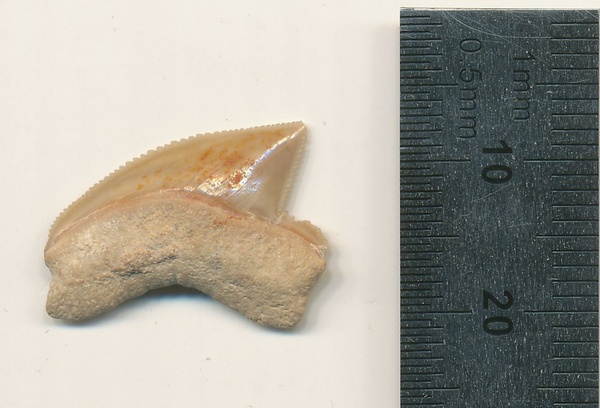Since the teeth were from 66,000,000 years ago, Late Cretaceous, The answer would seem to be simple; they were fossilized, found, and then moved. But why? Did did the owners know they were ancient fossils?
The teeth were found buried in material used to fill in a basement before conversion to a large Iron-Age house. The house itself was situated in the City of David, one of the oldest parts of Jerusalem. They were found together with fish bones thrown away as food waste 2,900 years ago, and other infill material such as pottery. They were found together with hundreds of bullae - items used to seal confidential letters and packages - implying a possible connection with the administrative or governing class at some point. Normally archaeological material is dated according to the circumstances where it is found, and so at first it was assumed that the teeth were contemporary.

Fossilized Squalicorax tooth Nr. #07815. Image: Omri Lernau
"We had at first assumed that the shark teeth were remains of the food dumped nearly 3000 years ago, but when we submitted a paper for publication, one of the reviewers pointed out that the one of the teeth could only have come from a Late Cretaceous shark that had been extinct for at least 66 million years," said Dr. Thomas Tuetken from the University of Mainz. "That sent us back to the samples, where measuring organic matter, elemental composition, and the crystallinity of the teeth confirmed that indeed all shark teeth were fossils. Their strontium isotope composition indicates an age of about 80 million years. This confirmed that all 29 shark teeth found in the City of David were Late Cretaceous fossils - contemporary with dinosaurs. More than that, they were not simply weathered out of the bedrock beneath the site, but were probably transported from afar, possibly from the Negev, at least 80 km away, where similar fossils are found."
Since then, they have found other shark teeth fossils elsewhere in Israel, at the Maresha and Miqne sites. These teeth are also likely to have been unearthed and moved from their original sites. The shark teeth which have been identified come from several species, including from the extinct Late Cretaceous group Squalicorax. Squalicorax, which grew to between 2 and 5 meters long, lived only during the Late Cretaceous period (which was the same period as the late dinosaurs), so acts as a reference point in dating these fossils.
There are no wear marks which might show that they were used as tools, and no drill holes to indicate that they may have been jewelry. Yet collectors would seem to be the only explanation, perhaps a fad in the Iron Age, since this was before Roman occupation and the area was wealthy. Cabbage Patch kids would certainly be a mystery to anyone 3,000 years from now.





Comments